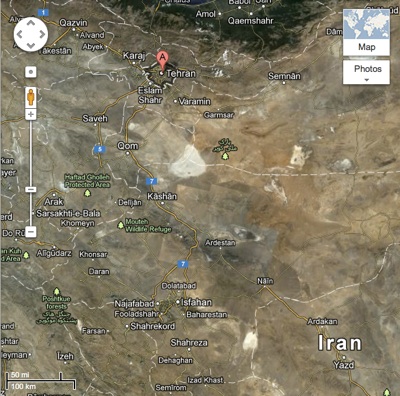North Africa ‘Plus’ Travel Diary

2011
Turkey Tunisia Algeria Iran Transnistria
Our main task today was to return to Tehran in order to catch our flight to Istanbul that will leave at 7 am tomorrow morning. The distance from Esfahan to Tehran is about 450 kilometres, and although there is an excellent expressway for almost the entire distance, marked with a largely ignored speed limit of 120 kilometres per hour, the trip took us from 8 am to 6 pm. Part of the reason was that Akba had hardly slept last night, and so his driving (and his walking, and his talking) tended to be quite a bit slower than usual. Still, driving on a 6-lane expressway at 85 kilometres per hour with the other cars zooming past at double the speed does give ample time for taking in the subtlety of the desert scenery and grabbing the odd photo through the windows.
One photo that I did think was especially interesting was a promotional sign encouraging women to wear the hijab (head covering). Beside a drawing of a woman wearing the hijab were Farsi words that Akba kindly translated for me as “The hijab is like the shell that covers the pearl inside” (see heading photo).
Anyway, apart from many multiple toilet stops to aid Akba’s concentration and comfort, we made just two stops on the journey.
Our first stop was in Kashan, an ancient city with about half a million people that is situated about 130 kilometres north of Esfahan. Kashan claims that it was the starting point for the Three Wise Men who travelled to Bethlehem to worship the baby Jesus, a claim that may have some substance given that the ‘Wise Men’ were magis (Zoroastrian priests), hence the ‘Adoration of the Magi’.
After a brief stop to admire the remains of Kashan’s city walls (for me, that is - Akba had another agenda, and Tim stayed in the car with the burglar alarm activated), we visited one of Kashan’s famous traditional houses. Kashan has hundreds of once-grand traditional houses that were built during the 19th century. Although most have since been sub-divided or left to collapse, several have been restored to their former glory. The house we visited was the Khan-e Borujerdi, which boasted an ornately decorated courtyard, laid out around a central fountain pool, and a two-storey reception hall at the far end, sumptuously decorated with beautiful murals and motifs.
Having taken in the Khan-e Borujerdi and taken a brief walk around the surrounding streets, we headed to the beautiful Fin Garden (which you may know better as the Bagh-e Tarikhi-ye Fin). Regarded as one of the finest gardens in Iran, the Fin Garden was designed to be a classical Persian vision of paradise. Although its most distinctive feature was its sensitive use of spring water, which flows into the garden from a pond at the top end of the garden, other lovely features included a couple of exquisite pavilions, a historic bath house, and of course the plants. The combination of shade and flowing water did indeed make this garden seem like a paradise compared with the dry 50 degree heat outside.
Before leaving Kashan, we stopped off for lunch, and to my delight, the meal I ordered was one of the best I have had in Iran. I ordered a traditional Iranian disk called fesenjon (there are apparently several spelling variations), which comprised a thin layer of some very tender pieces of chicken breast smothered in a thick dark brown/purple sauce which comprised a mix of chick peas, pomegranate and powdered walnuts, with just a dash of honey. I am told it was a very healthy meal, and the taste was exquisite. As I was also told that it is very easy to make, I have a mental note to myself to cook this myself one day before too long.
Our other stop today was on the outskirts of Tehran, this being the Holy Shrine of Imam Khomeini, the leader of the 1979 Islamic Revolution. The construction of the shrine has not yet been completed, but it is already enormous, being flanked by four 91 metre high towers symbolising Khomeini’s age when he died. The ayatollah wanted his shrine to be a public place where people could enjoy themselves, rather than a mosque where they must behave with reverence, and this is reflected in the people camping there, sitting around talking, not to mention the restaurants and shopping arcades that have also been established.
The shrine is located near Imam Khomeni International Airport (from which we will fly out tomorrow morning), which is about 30 kilometres south of Tehran city. I asked Akba why the new airport had been built so far from the city, and he replied “so it would be near Khomeni’s shrine”. I asked him why the shrine was located where it was, seemingly in the middle of nowhere, and he replied “It was placed there so arriving and departing passengers from the airport could see it from the window of their plane”.
We hit Tehran’s traffic and air pollution right in the middle of rush hour, at a little after 5 pm. It thus took an hour to get to our hotel, negotiating the daredevil, aggressive driving in Tehran while also asking several other drivers for directions through open windows, car-to-car, as we drove along. It was great to arrive safely at our hotel - Akba did a great job despite his tiredness and bowel issues.
Our room in Tehran looks very comfortable and the bed looks extremely inviting. It is a pity, therefore, that it has been necessary to set my alarm for 2:40 am tomorrow morning so we go to the airport to catch our early flight to Istanbul. Never mind, I’ll take whatever sleep I can get tonight.

Day 24 - Esfahan to Tehran, Iran
Wednesday
6 July 2011
Today’s Bonus Images
























